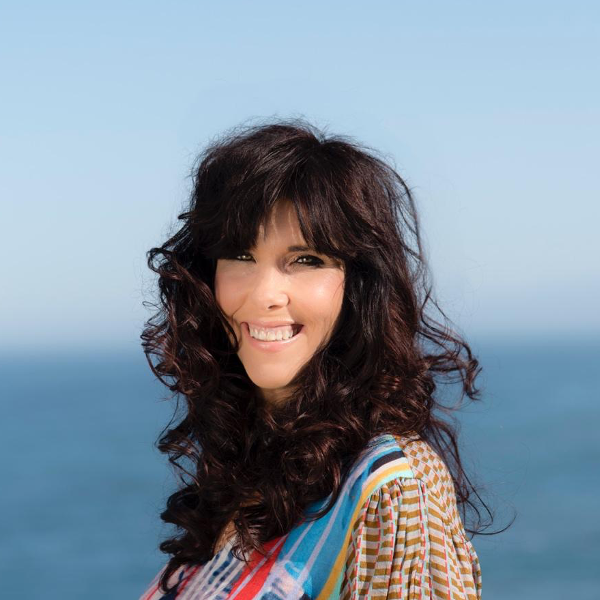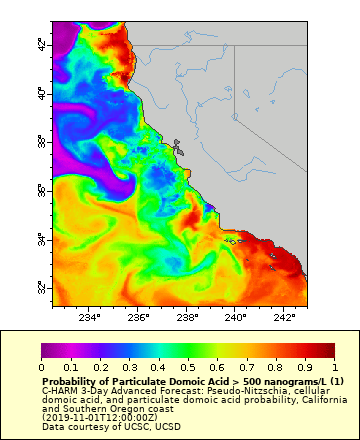Early Adopter

Applied Research Topic
Potential Applications ► HAB forecasting tool to protect ecosystem health and understand coastal ocean ecological dynamics
Description
Domoic acid (DA) poisoning in marine mammal/bird populations and the threat of Amnesic Shellfish Poisoning in humans is considered to be the leading harmful algal bloom (HAB) and conservation issue for much of the U.S. West Coast. The California Harmful Algae Risk Mapping (C-HARM) System provides when and where toxic blooms occur to better inform management decisions. We generate nowcast and forecast products routinely and in a pre-transitional demonstration of operational predictions of toxigenic blooms and DA toxins along the central California coast by merging: 1) ecological/empirical GLM models to 2) existing hydrodynamic model simulations (ROMS), 3) enhanced satellite imagery, 4) and community (Cal-HABMAP)/crowdsourced observations. The monthly California HAB Bulletin interprets C-HARM and all available observational information into an easy-to-read synthesis for managers and the public. End-user communities can use the bulletin to make informed decisions regarding C-HARM performance skill in order to better conduct targeted sampling and recovery efforts.Significance
C-HARM is used for decision-making by a wide suite of end users including, but not limited to: shellfish growing operations, marine mammal rescue decisions, retrospective analysis, public health sampling decisions, etc., and is incorporated into the widely subscribed California HAB Bulletin that is disseminated to federal, state, and regional partners as well as interested public.Why PACE
PACE will ensure continuity for C-HARM, a well-used and valued model by a wide range of California (and Oregon) stakeholders. We will use downscaled PACE spectral bands to replace MODIS and complement VIIRS sensor data. We are currently experimenting with source VIIRS data at full resolution (750m), gap-filling it, downsampling to the CA-ROMS grid/domain, and running the C-HARM model. Once simulated PACE products are available, we would process geophysical variables, downsample, and then project for the California domain using the same methods we have used for VIIRS. These data should be roughly a 1:1 fit for the requisite bands/variables (480 nm, 555 nm, derived Chlorophyll).End User(s)
End users of C-HARM include the marine mammal resource management community, shellfish growers, the CA Department of Fish and Wildlife (CDFW), the CA Department of Public Health ( CDPH), CA Office of Environmental Health and Hazard Assessment (OEHHA), fisherfolk (particularly Dungeness crab fleet), academics who monitor and study HABs, and State policy makers and policy influencers (e.g. CA Ocean Protection Council). NOAA Coast Watch West CoastNOAA NESDIS-STAR CoastWatch
SAT Partner(s)
Dave SiegelPublications
Anderson C.R., R.M. Kudela, M. Kahru, Y. Chao, F. Bahr, L. Rosenfeld, D. Anderson, and T. Norris (2016) Initial skill assessment of the California Harmful Algae Risk Mapping (C-HARM) System. Harmful Algae, 59, 1-18, DOI: https://doi.org/10.1016/j.hal.2016.08.006.
Kudela, R.M., S.A. Frolov, C.R. Anderson, and J.G. Bellingham (2013) Leveraging ocean observations to monitor and forecast harmful algal blooms: a case study of the U.S. West Coast, U.S. Integrated Ocean Observing System Summit Report.
Anderson, C.R., R.M. Kudela, C.R. Benitez-Nelson, E.S. Sekula-Wood, C. Burrell, Y. Chao, G. Langlois, J. Goodman, D.A. Siegel (2011) Detecting toxic diatom blooms from ocean color and a regional model. Geophysical Research Letters, 38, L04603, DOI: https://doi.org/10.1029/2010GL045858.
Anderson, C.R., D.A. Siegel, R.M. Kudela, M.A. Brzezinski (2009) Empirical habitat models of toxigenic Pseudo-nitzschia spp.: Potential use as a remote detection tool in the Santa Barbara Channel. Harmful Algae, 8: 478-492, DOI: https://doi.org/10.1016/j.hal.2008.10.005.
Anderson, C.R., M.A. Brzezinski, L. Washburn, R. Kudela (2006) Circulation and environmental conditions during a toxigenic Pseudo-nitzschia australis bloom in the Santa Barbara Channel, California. Marine Ecology Progress Series, 327: 119-133.



